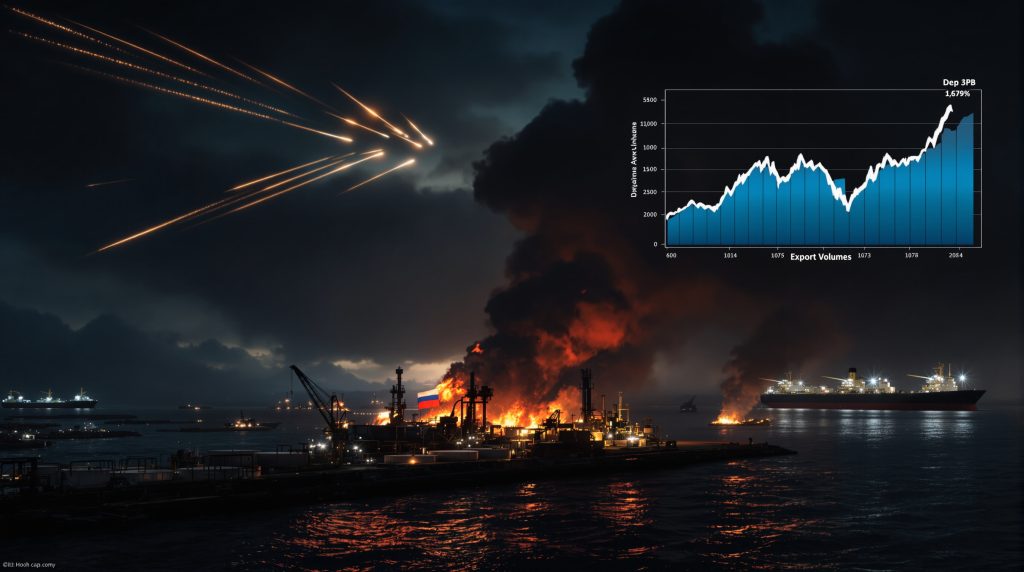Understanding Russian Oil Supply Risk: Geopolitical Challenges and Market Implications
The global oil market continues to face significant uncertainty due to ongoing challenges affecting Russian oil exports. Multiple factors—from geopolitical tensions to infrastructure vulnerabilities and sanctions enforcement—create a complex risk landscape that influences global energy security and oil price stagnation.
Geopolitical Tensions and Military Actions
Recent Ukrainian strikes on Russian energy infrastructure have intensified supply concerns. These targeted attacks have affected Russia's export capacity, with observable impacts on global oil shipments. The vulnerability of Russia's pipeline network and export terminals represents a persistent threat to stable supply flows as military activities continue to target critical energy assets.
Military actions specifically targeting energy infrastructure create unpredictable disruptions that ripple through global markets. Unlike scheduled maintenance or planned production adjustments, these strikes introduce a volatility factor that's difficult for market participants to hedge against effectively.
Sanctions Impact and Enforcement Evolution
The sanctions regime imposed by Western nations continues to reshape Russian oil export patterns. The enforcement mechanisms have evolved significantly, becoming more sophisticated and comprehensive in their coverage of the oil supply chain.
These measures have created persistent logistical challenges for Russian exporters, who must navigate increasingly complex shipping arrangements to maintain market access. The financial impact extends beyond simple revenue reduction, affecting Russia's ability to maintain and upgrade its aging energy infrastructure.
The secondary effects of sanctions on insurance markets, banking relationships, and shipping availability have compounded the primary restrictions, creating multiple layers of complexity for Russian oil exports.
How Has Russia Adapted Its Oil Export Strategy?
Shadow Fleet Operations and Challenges
To maintain export volumes despite sanctions, Russia has developed alternative shipping methods that operate outside standard international frameworks. This "shadow fleet" presents significant challenges beyond mere supply concerns.
| Shadow Fleet Risks | Impact Areas |
|---|---|
| Vessel safety standards | Higher accident probability |
| Environmental protection | Increased spill risks |
| Insurance coverage | Potential uncompensated damages |
| Regulatory compliance | Legal exposure for buyers |
| Tracking and transparency | Difficulty in monitoring flows |
This shadow fleet presents significant risks beyond just supply disruptions. Coastal nations along shipping routes face elevated environmental and financial hazards due to the increased likelihood of maritime accidents involving these poorly maintained vessels.
The vessels in this shadow fleet typically operate with minimal regulatory oversight, creating situations where safety standards may be compromised. Maritime experts note that these ships often sail with expired certifications, reduced crew training, and limited access to international ports for necessary maintenance.
Shifting Export Destinations
Russia has substantially redirected its export flows away from traditional European markets toward alternative buyers willing to manage the complexities of sanctions-adjacent transactions.
Asian buyers, particularly China and India, have increased their Russian oil imports substantially, creating new trade corridors and pricing dynamics. These shifts have fundamentally altered global oil trade patterns, creating less transparent supply chains that challenge traditional market monitoring.
The pricing mechanisms for these redirected exports have evolved, with complex discount structures that account for increased shipping costs, higher insurance premiums, and the legal complexities associated with sanctions navigation.
What Are the Market Implications of Russian Supply Disruptions?
Price Volatility Patterns
Russian supply uncertainties contribute significantly to oil market volatility, with oil price movements reflecting the market's sensitivity to potential disruptions.
Recent trading patterns demonstrate this impact clearly, with WTI and Brent futures showing that WTI crude at $63.79, up 2.28% after initial declines, and Brent crude climbing 2.40% to $67.96 following reports of fresh Russian oil supply risks. These rapid price reversals illustrate how quickly market sentiment can shift from oversupply concerns to supply security fears.
The volatility creates challenges for market participants attempting to manage risk through traditional hedging strategies. The unpredictable nature of geopolitical developments affecting Russian supply makes it difficult to accurately price risk premiums into forward contracts.
Global Supply-Demand Balance
The broader context of global oil supply affects how significantly Russian disruptions impact the market:
- OPEC+ production adjustments play a critical role in offsetting or amplifying Russian supply risks
- U.S. shale output growth has moderated, limiting the flexibility of alternative supply options
- Strategic petroleum reserves globally have been deployed previously, reducing this buffer mechanism
- Competing sanctioned sources like Iran remain constrained in their ability to increase exports
These factors create a relatively tight supply environment where Russian disruptions can have outsized price impacts despite overall adequate global supply. The psychological impact of potential disruptions often exceeds the actual volumetric impact, particularly when market sentiment is already fragile.
How Are Oil Buyers Managing Russian Supply Risk?
Hedging Strategies and Long-Term Contracts
Refiners in countries that continue to purchase Russian oil are implementing various risk management approaches to insulate themselves from potential disruptions:
- Negotiating longer-term supply agreements with flexible delivery terms
- Incorporating risk premiums into pricing structures to offset potential disruption costs
- Maintaining alternative supply options as contingency measures
- Adapting inventory management strategies to account for potential delivery delays
These approaches reflect the ongoing concerns about Russian supply reliability despite continued purchasing. The additional costs associated with these risk management strategies ultimately flow through to refined product pricing, affecting downstream markets.
Diversification Efforts
Major oil-importing nations are pursuing supply diversification strategies to reduce their exposure to Russian supply risks:
- Developing stronger relationships with Middle Eastern producers for consistent supply
- Exploring emerging production regions in Africa and the Americas
- Expanding domestic storage capacity to buffer against short-term disruptions
- Accelerating alternative energy development to reduce oil dependency long-term
These diversification efforts require significant investment and time to implement effectively, creating transitional vulnerabilities as energy systems adapt to new supply patterns and sources.
What Is the Outlook for Russian Oil Supply Risk?
Near-Term Scenarios
Several factors will influence Russian supply reliability in the coming months:
- Military developments: Continued or escalated attacks on energy infrastructure could further reduce export capacity
- Sanctions evolution: Potential changes to the sanctions regime could either tighten or loosen restrictions
- Technical challenges: Aging infrastructure and limited access to Western technology may create operational difficulties
- Seasonal factors: Winter weather conditions could compound logistical challenges for Russian exports
The interplay between these factors creates a complex risk environment that requires sophisticated scenario planning. Each factor introduces its own probability distribution and potential impact magnitude, making comprehensive risk assessment challenging.
Longer-Term Considerations
Looking beyond immediate concerns, several structural factors will shape Russian oil supply risk in the years ahead:
- Potential geopolitical resolution: A diplomatic resolution to the Ukraine conflict could significantly reduce supply risks
- Investment constraints: Continued limitations on technology transfer and capital access may gradually erode Russia's production capacity
- Infrastructure deterioration: Maintenance challenges could progressively impact export reliability
- Market adaptation: Global supply chains will continue evolving to account for Russian supply uncertainty
The long-term outlook depends heavily on Russia's ability to maintain its aging energy infrastructure without access to Western technology and expertise. The cumulative effect of deferred maintenance and limited technological upgrades could create structural production declines that persist regardless of geopolitical developments.
How Does Russian Supply Risk Affect Global Energy Security?
Regional Vulnerability Differences
The impact of Russian supply disruptions varies significantly by region, creating disparate risk profiles and policy responses:
- Europe: Despite reduced dependence, remains vulnerable to price effects and competition for alternative supplies
- Asia: Heavy importers like China and India face potential disruptions but benefit from discounted pricing
- North America: Less directly affected by physical supply but impacted by global price movements
- Developing economies: Often most vulnerable to price spikes resulting from supply uncertainty
These regional differences create complex dynamics in international energy diplomacy, as nations with different risk exposures pursue divergent policy objectives regarding Russian energy sanctions and alternative supply development.
Energy Transition Implications
Russian supply risk influences energy transition dynamics in several important ways:
- Supply uncertainty strengthens arguments for accelerating renewable energy deployment as a security measure
- Oil price volatility affects investment decisions in both fossil fuel and alternative energy projects
- Energy security concerns may prompt policy shifts regarding domestic production and strategic reserves
- Market signals about long-term Russian supply reliability influence infrastructure investment decisions
The energy security dimensions of Russian supply risk are increasingly intertwined with climate policy considerations, creating complex policy tradeoffs for governments attempting to balance immediate security concerns with longer-term sustainability objectives.
What Should Investors and Market Participants Monitor?
Key Risk Indicators
Several metrics provide insight into evolving Russian supply risk:
- Export volume data: Weekly and monthly shipment figures from Russian ports
- Shadow fleet activity: Changes in the number and patterns of vessels transporting Russian oil
- Price differentials: Urals crude discount to Brent as an indicator of market accessibility
- Refinery intake data: Processing volumes in major importing countries as a measure of actual consumption
- Sanctions compliance: Enforcement actions and policy statements from Western governments
These indicators should be monitored as an integrated dashboard rather than in isolation, as the interrelationships between different metrics often provide the most valuable insights into evolving risk dynamics.
Potential Market Surprises
Market participants should remain alert to several possible developments that could significantly impact Russian supply risk:
- Sudden infrastructure failures due to maintenance limitations
- New sanctions targeting specific aspects of Russia's export capabilities
- Technological breakthroughs enabling better sanctions enforcement
- Diplomatic developments that could either ease or intensify export restrictions
These potential surprises highlight the importance of maintaining flexible risk management strategies that can adapt to rapidly changing conditions in the Russian supply risk landscape.
The Persistent Nature of Russian Supply Risk
Russian oil supply risk remains a significant factor in global energy markets despite adaptation efforts by both exporters and importers. The combination of geopolitical tensions, sanctions regimes, and infrastructure vulnerabilities creates ongoing uncertainty that contributes to market volatility.
While some easing of these risks could occur with geopolitical resolution, the structural challenges facing Russian exports suggest that supply concerns will persist as a market factor. Market participants must continue monitoring developments closely while implementing appropriate risk management strategies.
The situation underscores how geopolitical factors can create lasting impacts on global energy flows, even in markets with adequate overall supply. As the energy transition progresses, these dynamics will continue influencing both fossil fuel markets and the pace of alternative energy development.
As demonstrated by recent market behavior, when oil prices at first declined on oversupply concerns but then rapidly rebounded on Russian supply risk fears, the market remains highly responsive to changing perceptions of Russian export reliability. This price volatility illustrates the premium that markets place on supply security in an environment where tariffs and market impact from geopolitical tensions such as the US-China trade war can rapidly shift the supply-demand balance.
The complexity of Russian oil supply risk necessitates a multifaceted approach to risk management that integrates geopolitical analysis, technical infrastructure assessment, and market intelligence from energy experts to develop robust strategies for navigating an increasingly uncertain energy landscape.
Ready to Stay Ahead of Energy Market Volatility?
Discover how major mineral discoveries can significantly impact your investment portfolio by exploring Discovery Alert's dedicated discoveries page, where their proprietary Discovery IQ model delivers real-time alerts on significant ASX mining opportunities, helping you capitalise on market movements before they happen.




